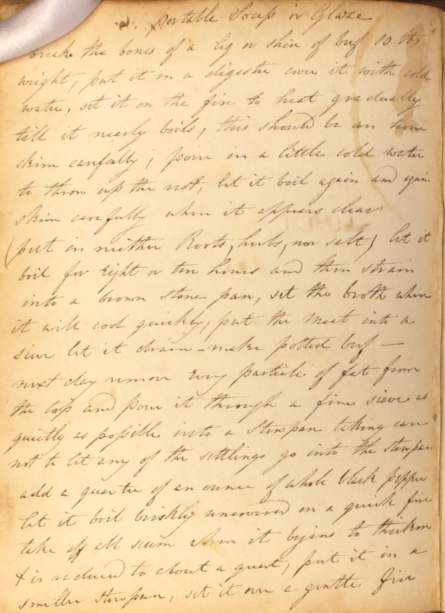Portable soup was the Regency equivalent of the modern-day stock cube.
It wasn’t until the 20th century that companies such as Oxo started mass-producing dehydrated stock. Before then, most households had prepared fresh stock from scratch and, in cases where a preserved supply was needed, made their own cubes of ‘portable soup’. This recipe, transcribed from Kitchiner’s Cook’s Oracle, shows how it was done:

A Regency recipe for ‘portable soup’, transcribed into The Cookbook of Unknown Ladies from Kitchiner’s Cook’s Oracle
Portable Soup or Glaze
Break the bones of a leg or shin of beef, 10 lbs weight. Put it in a digester, cover it with cold water, set it on the fire to heat gradually till it nearly boils. This should be an hour. Skim carefully, pour in a little cold water to throw up the rest. Let it boil again and again. Skim carefully when it appears clear (put in neither roots, herbs nor salt). Let it boil for eight or ten hours and then strain into a brown stone pan. Set the broth where it will cool quickly. Put the meat into a sieve. Let it drain – make potted beef – next day remove every particle of fat from the top and pour it through a fine sieve, as quietly as possible, into a stewpan, taking care not to let any of the settlings go into the stewpan. Add a quarter of an ounce of whole black pepper. Let it boil briskly, uncovered, on a quick fire. Take off all scum when it begins to thicken & is reduced to about a quart. Put it in a smaller stewpan, set it over a gentle fire till reduced to the thickness of a very thick syrup. Take care it does not burn. Try a little out in a spoon. If it sets into jelly, it is done. If not, boil a little till it does. Have some little pots an inch & half deep. Take care they are quite dry.
The ‘digester’ in which this jellied stock would have been prepared was a forerunner of today’s pressure cookers, and would have certainly helped to speed up the cooking down of the beef bones. Nevertheless, preparing portable soup was a laborious process. As it formed, the stock needed to be regularly skimmed of fat – the smallest amount could otherwise turn rancid over time and badly affect the taste of the finished product.
Prepared with care and stored in a dry place, this kind of jellied bouillon could be kept for some time. When needed, the cubes would be quickly reconstituted into soup with the addition of boiling water, herbs and seasoning. Who needs Pot Noodle when you have portable soup?

Does any one remember the portable soup found by the Swiss Family Robinson? I always wondered how they were made and why they didn’t go bad. Are they only safe in a cool climate?